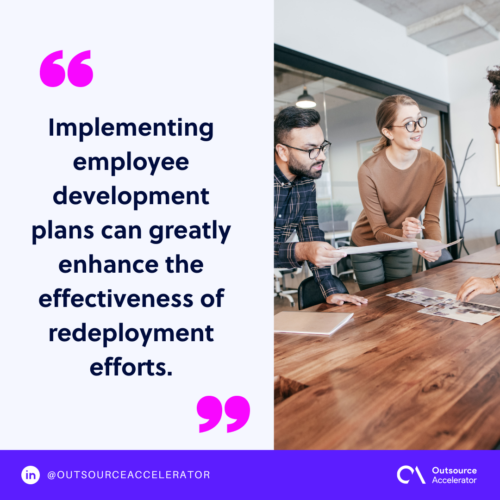Overview of Redeployment Strategies

Organizations facing rapid changes in technology, market conditions, and economic shifts are increasingly turning to redeployment strategies in order to retain critical talent and avoid layoffs. Redeployment is a strategic process in which employees are reassigned to new roles or offered additional training to meet evolving business needs, rather than being made redundant[1]. This approach has been used by companies such as Apple during the pandemic and can be adapted to other sectors, including call centers, where displaced workers can be retrained for higher-value roles.
Strategic Approaches to Workforce Redeployment
A number of effective strategies have emerged that provide a replicable playbook for redeployment. These include internal job posting systems that allow employees to apply for roles that align with their skills, as well as scenarios where management assigns roles directly after conducting comprehensive skills assessments[1]. In some cases, a hybrid approach is used that combines employee choice with targeted assignments to quickly fill critical gaps while offering comprehensive training, trial periods to assess new roles, and career coaching to aid in transitions[3].
Collaboration Across Sectors
Successful redeployment often hinges on effective partnerships among government bodies, technology firms, and non-governmental organizations (NGOs). Public-private alliances form the backbone of many reskilling efforts as governments and industry leaders join forces to address skills gaps and economic uncertainties. Initiatives have been launched where governments, academic institutions, and tech companies develop flexible training programs aimed at countering the disruption caused by automation and digital transformation[4]. Such alliances ensure that displaced workers—whether from retail, call centers, or other sectors—gain access to modern digital skills and more sustainable career paths.
Co-creation and Cross-sector Leadership Models
A major component of successful redeployment is collaborative design. One notable example is the Reskilling Displaced Retail Workers project, which established a Collaboration-Impact Framework that unites multiple stakeholders. This framework emphasizes clear communication, shared values, and transparency in designing comprehensive re-skilling and placement programs[5]. Although originally designed for retail workers, the principles of co-creation, stakeholder engagement, and shared intellectual property can be directly applied to projects aimed at retraining call-center agents for higher-value roles. Bringing together diverse organizations—each with complementary strengths—ensures that training programs are well-rounded and effectively address systemic barriers that workers face.
Replicable Playbooks from Case Studies
Several case studies provide instructive insights for agencies considering the redeployment of displaced call-center workers. First, the playbook from the HR best practices literature emphasizes the importance of transparent communication, skills assessment, and trial periods. This playbook recommends that a co-created internal job posting mechanism be accompanied by career coaching services and potentially, severance packages if redeployment is not a suitable option[1].
Another playbook example comes from the Re-skilling Displaced Retail Workers project, where four phases were used—concept generation, research, design, and prototyping—to ensure that training programs are tailored to the needs of specific worker groups. A significant insight from this project is the reliance on inclusive, community-based participatory research to identify the primary barriers and training needs of displaced workers, leading to the design of blended virtual and in-person training opportunities that include paid work-integrated learning opportunities[2].
Similarly, rapid workforce redeployment strategies detailed by talent management experts illustrate that real-time data analytics and AI-driven insights can be leveraged to match employees to roles with minimal disruption. This method reduces recruitment and training costs, preserves intellectual capital, and improves overall employee morale by revealing hidden skills and facilitating cross-department collaboration[3].
Implementing a Cross-sector Redeployment Program for Call-Center Workers
Drawing on the lessons from multiple sectors, a replicable playbook for redeploying displaced call-center workers should begin with a comprehensive audit of employee skills and career aspirations. Employers, potentially in partnership with local government agencies and NGOs, can then organize a series of co-creation sessions to develop training content tailored to the needs of call-center workers. This content should include both technical upskilling in digital customer service channels and soft skills training to better align with roles in emerging technology-driven areas. Following the training phase, a trial period allowing both the employer and the employee to assess role fit is critical, as is transparent, supportive communication during the entire process[1].
Moreover, integrating digital tools and platforms can enhance the matching process between employee capabilities and available roles. Technology firms can provide software solutions that enable real-time skills tracking and competency assessments, ensuring that redeployment is both efficient and data-driven. This integration aligns with public-private partnerships seen in broader workforce reskilling initiatives, where confidence in digital solutions is a shared element among governments, academic institutions, and corporate entities[4].
Lastly, establishing feedback loops with all stakeholders—including affected employees, training providers, and managers—ensures continuous improvement of the redeployment program, making it adaptable to future disruptions and expanding its impact across various sectors.
Conclusion
The case studies and frameworks detailed in this report highlight how cross-sector alliances can successfully redeploy displaced workers by combining government support, technological innovation, and NGO engagement. The replicable playbooks described include critical elements such as comprehensive skills assessments, co-created training programs, trial periods for new roles, and data-driven matching processes. By focusing on these components, organizations can not only mitigate the adverse effects of workforce displacement but also create sustainable pathways for career progression, ensuring that displaced call-center workers move into higher-value roles with confidence and support.
Get more accurate answers with Super Pandi, upload files, personalized discovery feed, save searches and contribute to the PandiPedia.
Let's look at alternatives:
- Modify the query.
- Start a new thread.
- Remove sources (if manually added).



![Secure Grants offering more than $1 Million for Major Projects [Europe] Secure Grants offering more than $1 Million for Major Projects [Europe]](https://www2.fundsforngos.org/wp-content/uploads/2024/11/eBook-Cover-Spiral-copy-2-1-1-238x300.png)





